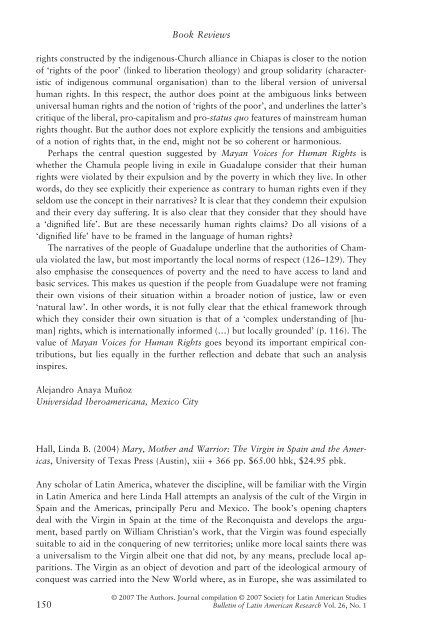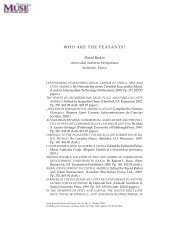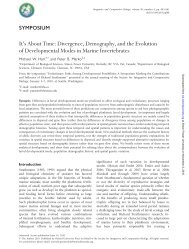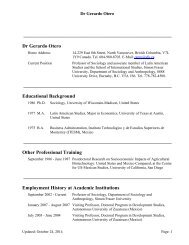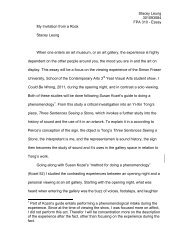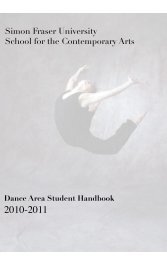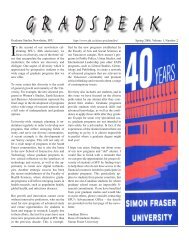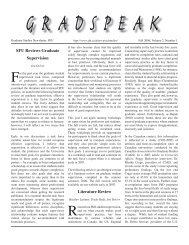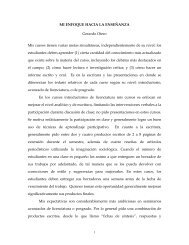Review of Mexico in Transition by Byron Crites
Review of Mexico in Transition by Byron Crites
Review of Mexico in Transition by Byron Crites
- TAGS
- transition
- byron
- crites
- cgi.sfu.ca
You also want an ePaper? Increase the reach of your titles
YUMPU automatically turns print PDFs into web optimized ePapers that Google loves.
Book <strong>Review</strong>s<br />
rights constructed <strong>by</strong> the <strong>in</strong>digenous-Church alliance <strong>in</strong> Chiapas is closer to the notion<br />
<strong>of</strong> ‘ rights <strong>of</strong> the poor ’ (l<strong>in</strong>ked to liberation theology) and group solidarity (characteristic<br />
<strong>of</strong> <strong>in</strong>digenous communal organisation) than to the liberal version <strong>of</strong> universal<br />
human rights. In this respect, the author does po<strong>in</strong>t at the ambiguous l<strong>in</strong>ks between<br />
universal human rights and the notion <strong>of</strong> ‘ rights <strong>of</strong> the poor ’ , and underl<strong>in</strong>es the latter ’ s<br />
critique <strong>of</strong> the liberal, pro-capitalism and pro- status quo features <strong>of</strong> ma<strong>in</strong>stream human<br />
rights thought. But the author does not explore explicitly the tensions and ambiguities<br />
<strong>of</strong> a notion <strong>of</strong> rights that, <strong>in</strong> the end, might not be so coherent or harmonious.<br />
Perhaps the central question suggested <strong>by</strong> Mayan Voices for Human Rights is<br />
whether the Chamula people liv<strong>in</strong>g <strong>in</strong> exile <strong>in</strong> Guadalupe consider that their human<br />
rights were violated <strong>by</strong> their expulsion and <strong>by</strong> the poverty <strong>in</strong> which they live. In other<br />
words, do they see explicitly their experience as contrary to human rights even if they<br />
seldom use the concept <strong>in</strong> their narratives? It is clear that they condemn their expulsion<br />
and their every day suffer<strong>in</strong>g. It is also clear that they consider that they should have<br />
a ‘ dignifi ed life ’ . But are these necessarily human rights claims? Do all visions <strong>of</strong> a<br />
‘ dignifi ed life ’ have to be framed <strong>in</strong> the language <strong>of</strong> human rights?<br />
The narratives <strong>of</strong> the people <strong>of</strong> Guadalupe underl<strong>in</strong>e that the authorities <strong>of</strong> Chamula<br />
violated the law, but most importantly the local norms <strong>of</strong> respect (126 – 129). They<br />
also emphasise the consequences <strong>of</strong> poverty and the need to have access to land and<br />
basic services. This makes us question if the people from Guadalupe were not fram<strong>in</strong>g<br />
their own visions <strong>of</strong> their situation with<strong>in</strong> a broader notion <strong>of</strong> justice, law or even<br />
‘ natural law ’ . In other words, it is not fully clear that the ethical framework through<br />
which they consider their own situation is that <strong>of</strong> a ‘ complex understand<strong>in</strong>g <strong>of</strong> [human]<br />
rights, which is <strong>in</strong>ternationally <strong>in</strong>formed ( … ) but locally grounded ’ (p. 116). The<br />
value <strong>of</strong> Mayan Voices for Human Rights goes beyond its important empirical contributions,<br />
but lies equally <strong>in</strong> the further refl ection and debate that such an analysis<br />
<strong>in</strong>spires.<br />
Alejandro Anaya Muñoz<br />
Universidad Iberoamericana, <strong>Mexico</strong> City<br />
Hall, L<strong>in</strong>da B. (2004) Mary, Mother and Warrior: The Virg<strong>in</strong> <strong>in</strong> Spa<strong>in</strong> and the Americas<br />
, University <strong>of</strong> Texas Press (Aust<strong>in</strong>), xiii + 366 pp. $65.00 hbk, $24.95 pbk.<br />
Any scholar <strong>of</strong> Lat<strong>in</strong> America, whatever the discipl<strong>in</strong>e, will be familiar with the Virg<strong>in</strong><br />
<strong>in</strong> Lat<strong>in</strong> America and here L<strong>in</strong>da Hall attempts an analysis <strong>of</strong> the cult <strong>of</strong> the Virg<strong>in</strong> <strong>in</strong><br />
Spa<strong>in</strong> and the Americas, pr<strong>in</strong>cipally Peru and <strong>Mexico</strong>. The book ’ s open<strong>in</strong>g chapters<br />
deal with the Virg<strong>in</strong> <strong>in</strong> Spa<strong>in</strong> at the time <strong>of</strong> the Reconquista and develops the argument,<br />
based partly on William Christian ’ s work, that the Virg<strong>in</strong> was found especially<br />
suitable to aid <strong>in</strong> the conquer<strong>in</strong>g <strong>of</strong> new territories; unlike more local sa<strong>in</strong>ts there was<br />
a universalism to the Virg<strong>in</strong> albeit one that did not, <strong>by</strong> any means, preclude local apparitions.<br />
The Virg<strong>in</strong> as an object <strong>of</strong> devotion and part <strong>of</strong> the ideological armoury <strong>of</strong><br />
conquest was carried <strong>in</strong>to the New World where, as <strong>in</strong> Europe, she was assimilated to<br />
© 2007 The Authors. Journal compilation © 2007 Society for Lat<strong>in</strong> American Studies<br />
150 Bullet<strong>in</strong> <strong>of</strong> Lat<strong>in</strong> American Research Vol. 26, No. 1


